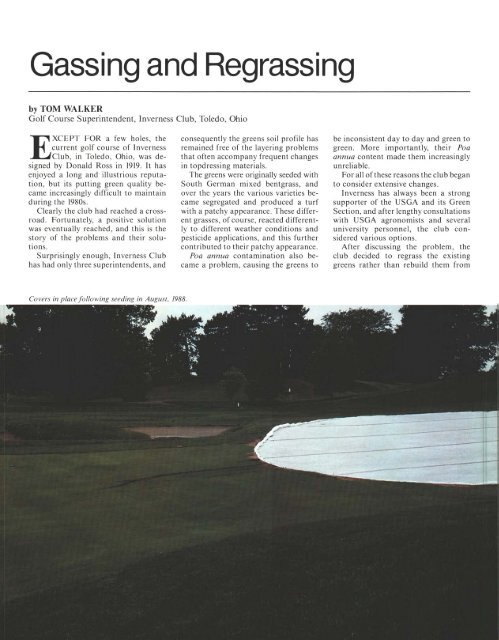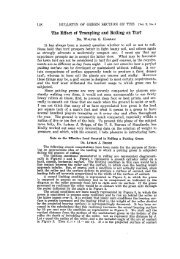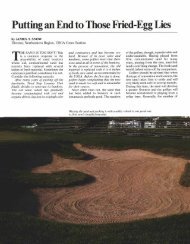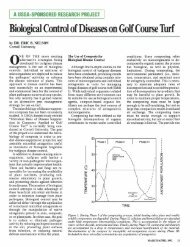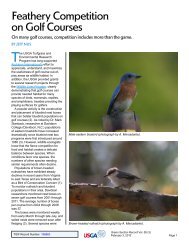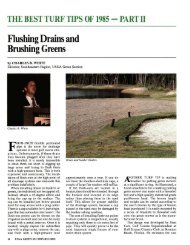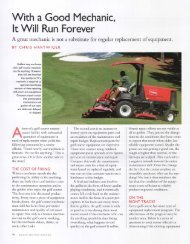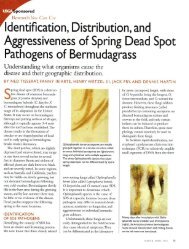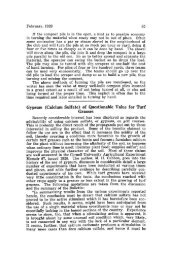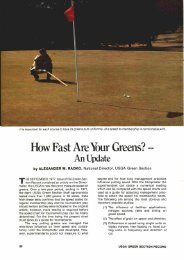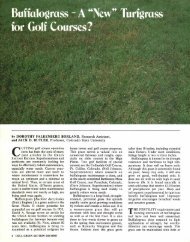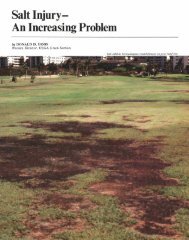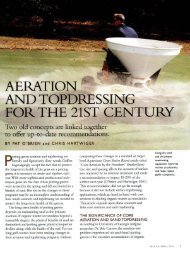Gassing and Regrassing - USGA Green Section Record
Gassing and Regrassing - USGA Green Section Record
Gassing and Regrassing - USGA Green Section Record
You also want an ePaper? Increase the reach of your titles
YUMPU automatically turns print PDFs into web optimized ePapers that Google loves.
<strong>Gassing</strong> <strong>and</strong> <strong>Regrassing</strong>by TOM WALKERGolf Course Superintendent, Inverness Club, Toledo, OhioEXCEPT FOR a few holes, thecurrent golf course of InvernessClub, in Toledo, Ohio, was designedby Donald Ross in 1919. It hasenjoyed a long <strong>and</strong> illustrious reputation,but its putting green quality becameincreasingly difficult to maintainduring the 1980s.Clearly the club had reached a crossroad.Fortunately, a positive solutionwas eventually reached, <strong>and</strong> this is thestory of the problems <strong>and</strong> their solutions.Surprisingly enough, Inverness Clubhas had only three superintendents, <strong>and</strong>consequently the greens soil profile hasremained free of the layering problemsthat often accompany frequent changesin topdressing materials.The greens were originally seeded withSouth German mixed bentgrass, <strong>and</strong>over the years the various varieties becamesegregated <strong>and</strong> produced a turfwith a patchy appearance. These differentgrasses, of course, reacted differentlyto different weather conditions <strong>and</strong>pesticide applications, <strong>and</strong> this furthercontributed to their patchy appearance.Poa annua contamination also becamea problem, causing the greens tobe inconsistent day to day <strong>and</strong> green togreen. More importantly, their Poaannua content made them increasinglyunreliable.For all of these reasons the club beganto consider extensive changes.Inverness has always been a strongsupporter of the <strong>USGA</strong> <strong>and</strong> its <strong>Green</strong><strong>Section</strong>, <strong>and</strong> after lengthy consultationswith <strong>USGA</strong> agronomists <strong>and</strong> severaluniversity personnel, the club consideredvarious options.After discussing the problem, theclub decided to regrass the existinggreens rather than rebuild them fromCovers in place following seeding in August, 1988.
scratch. This idea was well received bythe club membership, which was extremelyconcerned about preservingwhat is left of the original Ross design.<strong>Regrassing</strong> was a particularly viablealternative, since the old soil greens hadalways drained well. In addition, theundulations on the greens, for which theclub has long been noted, providedexcellent surface drainage.Cost was also a consideration, sincethe estimates for reconstruction were inexcess of $400,000, while the regrassingestimates were only $40,000. Obviously,the changes being considered were monumental,<strong>and</strong> the club wanted to beabsolutely sure the best option waschosen so that the fundamental problemswould be solved while the integrityof the original design was preserved.In order to gain firsth<strong>and</strong> informationabout the merits of regrassingversus reconstruction, as well as toevaluate the various choices for grassselection, a delegation of club officialsvisited a number of coures in Indiana,New Jersey, <strong>and</strong> Delaware. I went along.As noted earlier, the regrassing programwas selected in lieu of total reconstruction.Pennlinks was our choicefor putting green turf because of itsaggressive, deep-rooting nature as wellas its upright growth <strong>and</strong> fine texture.Deciding how to proceed with theproject was our next step. Proposalsincluded (a) regrassing all 18 greensimmediately, (b) doing nine greens oneyear <strong>and</strong> nine the next, <strong>and</strong> (c) regrassingjust two greens on a trial basis.Even though we felt very confidentabout regrassing all 18 greens at onetime, the knowledge that the projectwould thoroughly disrupt the golf season<strong>and</strong> that the trial program wouldallow us to fine-tune our program ledus to choose that method.August 27, 1988, was our target seedingdate for the two trial greens, but rainforced a four-day delay, <strong>and</strong> the greenswere not seeded until September 1st.Because of this delay <strong>and</strong> because wedid not verticut thoroughly enough inpreparing the seedbed, germination percentageswere not as high as we wouldhave liked. Nonetheless, the finishedproduct turned out extremely well, <strong>and</strong>the trial was an undeniable success.The two trial greens were opened onMay 31st, 1988, just nine months afterthe regrassing project had begun. Atthat time they rolled 8 feet 6 inches onthe Stimpmeter.Armed with this excellent experience,planning began for regrassing the othereighteen greens. The timetable <strong>and</strong> thescope of the work for the remainingThe finished product eight months later.
greens had been set in October of 1987.It was decided to change the contour ofthe sixth green <strong>and</strong> to make minorchanges in the fifth green, two holesadded by George <strong>and</strong> Tom Fazio for the1979 U.S. Open, but no other changeswere to be made. August 15, 1988, wasour target seeding date, giving us moretime for fall grow-in.Precise planning was essential, sincethe operation involved several consultants<strong>and</strong> contractors. Arrangementswere made to have extra equipment <strong>and</strong>parts on h<strong>and</strong> in the event of breakdowns.Our efforts <strong>and</strong> planning paidoff h<strong>and</strong>somely, as everything wentexactly according to the plan.Regrading work began on the sixthgreen on August 1 <strong>and</strong> was completedby August 7, so that it could be fumigated<strong>and</strong> seeded along with the rest ofthe greens. Work began on the remaininggreens with an aerification programon August 8.In order to protect the green contours,we had originally planned toaerify once with the Verti-Drain deeptineaerifier <strong>and</strong> twice with Ryan<strong>Green</strong>saires before we removed the sod.This turned out to be impractical, however,because the sod broke into smallpieces <strong>and</strong> was difficult to remove. Tospeed the process, the sod was removedafter using the Verti-Drain but beforeaerifying with the Ryans.Following core removal, a contractorthen moved in <strong>and</strong> performed methylbromide fumigation on August 10 <strong>and</strong>11. After 48 hours, the plastic tarps wereremoved, <strong>and</strong> the greens were allowedto breathe for an additional 24 hours.Seedbed preparation began by verticuttingto a depth of Ys inch in fourdirections. Finally, the greens were carefullyraked to preserve their originalcontours.After a light irrigation, the soil surfacewas raked again, <strong>and</strong> X A lb. N/1,000sq. ft. was applied using a 10-18-22predominantly soluble fertilizer. Thismaterial was incorporated with anotherlight raking.Pennlinks creeping bentgrass seed wasapplied with drop spreaders in twodirections, each at % lb./1,000 sq. ft.Granular metalaxyl (Subdue) wasapplied to control Pythium, <strong>and</strong> theseed <strong>and</strong> fungicide were incorporatedwith a final raking. Great care was takento erase all footprints to produce a perfectlysmooth putting surface.Vigorous root system of Pennlinks creeping bent after eight months.Geotextile covers were placed overthe greens to prevent erosion during thegermination <strong>and</strong> establishment phase.They were not easy to install withoutdisturbing the seedbed, <strong>and</strong> 15 peoplewere required to float them over thegreen, much as you would a parachute.To illustrate the value of the covers, 1.75inches of rain fell the night we seededthe greens, <strong>and</strong> even though some minorerosion occurred, it was far less thanwould have occurred had the covers notbeen used.Soil thermometers proved to be invaluable,since soil temperatures can beas much as 20 degrees warmer under acover in the sun than in the shade.Temperatures were monitored closely,<strong>and</strong> when they rose to 90 degrees orhigher, one-minute syringe cyclescooled them.The covers were removed after fivedays, <strong>and</strong> were replaced only when rainthreatened. There was no danger of erosionafter three weeks, <strong>and</strong> the coverswere not used again until winter.The first mowing occurred at 14 days,<strong>and</strong> by 21 days the greens were beingmowed three to five times a week at aheight of !4 inch. Two weeks after seeding,soluble 10-18-24 fertilizer was usedat a rate of V 4 lb. N/1,000 sq. ft. on afour-day cycle. Eventually, the fertilizationprogram evolved such that weeklyapplications were made at a rate of'/3 to 1/2 lb. N/1,000 sq. ft. By lateOctober, 4 lbs. N/1,000 sq. ft. had beenapplied, <strong>and</strong> growth <strong>and</strong> developmentwere excellent.Fungicides were applied as needed ona 14- to 21-day cycle, <strong>and</strong> three lighttopdressings were made in the fall. Thegeotextile covers were replaced in lateNovember <strong>and</strong> were kept in place untilMarch.As of April 12,1989, just eight monthsafter seeding, cutting heights have beenlowered to less than l A inch, <strong>and</strong> theputting green surfaces are quite smooth.Root growth has been exceptional, withroots commonly found at depths of 8 to10 inches. Opening day is planned forsometime in May, which translates to atotal downtime of just nine months.At this point I could not be happierwith our renovation project. It has proceededbeautifully from start to finish.The total regrassing project, includingthe reconstruction of the sixth green,cost less than $40,000, one-tenth of thecost of the original estimated reconstructioncost of $400,000. <strong>Regrassing</strong>certainly is not a viable alternative inevery situation, but it has workedwonderfully at Inverness, <strong>and</strong> at a muchlower cost.


